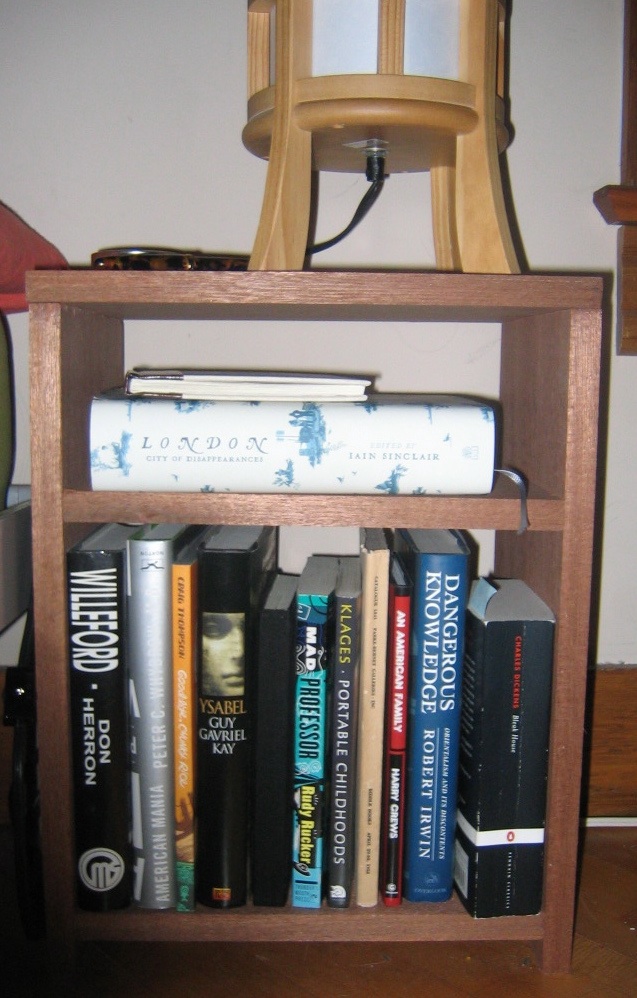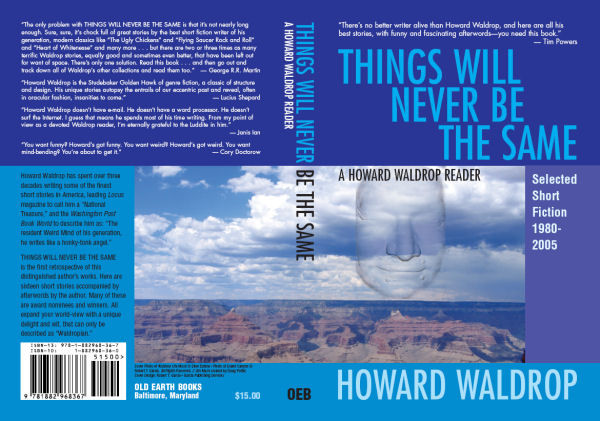
March 2007

30 March 2007
Cover Story
I am pleased to report that my review of The Darkening Garden. A Short Lexicon of Horror by John Clute is the cover story of the March issue of NYRSF , with the witty portrait of Clute by Jason van Hollander (see under FUSTIAN ).
Send for a copy of the issue ; send for a copy of the book.
Another post this evening.
Public Transport Reading Project 07
30 March
07 : Hoboken PATH train, four women readers : late forties, Chesterfield
coat of black and white houndstooth check and red grid, Shopaholic & Baby by Sophie Kinsella, hardcover ; and three others, paperback (Me : The Library Window by Margaret Oliphant ).
Uptown F train, four women readers : young woman, The Secret Garden , paperback ; and three others, paperback ;
one man, twentyish, paperback.
Downtown N train, crowded, five men : The Selfish Gene (Japanese edition), paperback ; technical manual, thick paperback ; The
Storm of . . . by George R. R. Martin(partial sighting), paperback ; and two others ; three women : The Inheritance of Loss ,
paperback, and two others.
NJ Transit : distinguished older man, Six Frigates. The Epic History of the Founding of the U.S. Navy by
Ian W. Toll, hardcover. [HW]
29 March 2007
Mundane Journeys. Field Guide to Color by Kate Pocrass
I received another great book in the mail, Mundane Journeys. Field Guide to Color , the latest production from Kate Pocrass and Mundane Journeys. This is a scan of the inside front cover and title page :
This book
is a direct outgrowth of the earlier book, rooted in careful observation
of specific places in San Francisco. The principal focus is upon color in
context, and the book makes good use of design cues to embody the integrity
of form and function : I particularly enjoyed the play of number and
color along the bottom of pages 8-9. The artist’s sense of humor is everywhere
apparent, and also of note is the way Pocrass constantly urges the reader
to become a participant and not merely a spectator. Some time back my brother
had sent me a color card made by Pocrass for a site-specific event, which
gave some indication of where her work was going, and her attention to a
new order of visual information. This little gem demonstrates that a quantum,
evolutionary leap has occured. Pocrass gives us actual tools to see the city
(cities) we never see.
The Field Guide to Color is divided into four sections, Mundane
Façades,
Mundane Things People Eat, Mundane Systems & Eccentricities, and Mundane
Coincidences & Interjections. I enjoyed the look at bubble gum flavors and
colors (24-25) ; and the passage about the books on the SF Public Library shelves. The
anecdotes
accompanying
the
observations
are a little more discursive than in the first book ;
which allows the reader see the artist/author exploring the association between
color
and
memory. The methodlogy works : already by the time the morning train entered
the swamps of the Meadowlands, I had begun to look (and think) in terms of variations
of browns and greys. This
is a fun and provocative work — a book whose implications spill beyond
its
pages.
Public Transport Reading Project 07
29 March
07 : NJ Transit to NYC, white-haired gent on the seat near me,
halfway through The Aeneid, Fagles translation (I asked), black hardcover, without
dust jacket. (Me : Mundane Journeys. Field Guide to Color ).
Penn Station, NYC, escalator, black-haired gent in dark grey raincoat, Marathon Man by
William Goldman.
Uptown W train, four women readers : Michael Connelly, The Lincoln Lawyer ,
paperback ; Breaking Open the Head. A Psychedelic Journey into the Heart of Contemporary Shamanism by Daniel Pinchbeck, paperback ; and two others (paperback) ;
one man, skinny book or pamphlet.
Downtown N train, five women readers : twentyish woman with dyed brown and
blonde hair, The Twentieth Wife by Indu Sundaresan, paperback ;
young Asian woman, Never
Let Me Go by Kazuo Ishiguro, paperback thirtyish woman, Dune ,
(old)
paperback ;
one man, fortyish, rimless glasses, grape necktie with yellow dots, The Queen’s
Fool , paperback. [HW]
28 March 07 : 42nd St. uptown 6 station, stiff-looking fortyish guy, belt too tight, long shirt sleeves too short, reading Tuchman’s The Guns of August , paperback. (Me : old Penguin paperback of Northanger Abbey ). Routine observation / query : Why do so many middle-aged men, mostly business types, favor fat biographies of statesmen ? [TW]
27 March 2007
Public Transport Reading Project 07
It’s
SIMPLE ! It’s FUN ! Ask yourself ! Ask others !
What BOOK are you reading on the bus or train or subway ?
What COLOR is the cover of the book you are reading on the train or
subway or
bus ?
What BOOKS have you seen PEOPLE reading on the subway or bus or train ?
Which city or town are you reporting from ?
Please let us know — e-mail to wessells [at] aol [dot] com or by postcard
to :
Temporary Culture, P.O.B. 43072, Upper Montclair, NJ 07043 USA
So once I regained control of my computer, I designed a flyer to print and to hand to people when I ask, What are you reading ?
26 March 2007
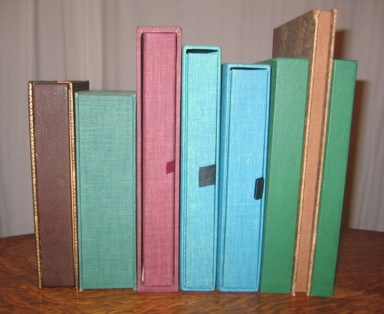
This anonymous bookshelf will serve as visual record of a recent trip. (Early morning, in a moderate degree of haste. Another post this evening.)
Bonus picture from a hotel library : left behind.
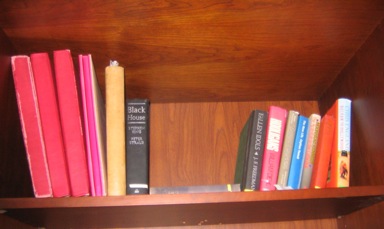
Livres de Chevet
“ Je n’ai pas de livres de chevet :
je ne m’endormirais jamais. ” (I have no bedside reading :
I would never get to sleep.) — Charles
Dantzig, Dictionnaire égoïste de la littérature
française .
I do have a bedside table ; and I am reminded
that the very first book reviews I wrote for AB Bookman’s Weekly were of Mark
Samuels Lasner’s Selective Checklist of the Published Work of Aubrey Beardsley (Thomas
G. Boss, 1995); and of an anthology published by David Godine, Reading in Bed. Personal Essays on the Glories of Reading selected & edited by Steven Gilbar (1995 ;
new ed., 2007).
Michael Dirda has an interesting review essay on Howard Waldrop in today’s Washington Post Book World :
Italo Calvino once said that he was “ known as an author who changes greatly from one book to the next. And in these very changes you recognize him as himself. ” Much the same could be said of Howard Waldrop. You never know what he’ll come up with next, but somehow it’s always a Waldrop story.
Old Earth Books are publishing a new collection of stories : Things Will Never Be the Same. A Howard Waldrop Reader. Selected Short Fiction, 1980-2005 . I can’t wait to read it.
First Things First
The Week
in Books : Readings and Sightings
Reader TW called me up to remind me of the need to enable direct comment
on the Endless Bookshelf and to inquire about the dimensions of the Modular
Semi-Transparent
Plastic Bookshelf and to discuss the ongoing Public Transport Reading Week. How
many titles by Sue Grafton do you want to list ? he asked, it is the
exceptions
that will prove most interesting. I said that I had not sighted any titles
by Sue Grafton to date but had learned of authors such as Catherine Coulter. And
if you were to see what I have been lugging around, it would be decidedly exceptional,
I said. I’m reading Out of Print & into Profit. A
History of the Rare & Secondhand Book Trade in Britain in the Twentieth Century ,
edited by Giles Mandelbrote (The British Library and Oak Knoll Press, 2006).
I’m reading
that too, remarked TW. Thereby making two of us commuter-readers in the metropolitan
New
York
area and dispelling any notion of exceptionalism. Oh well, someday this project
will find its stride.
Out of Print & into Profit is a hefty, well-illustrated book,
twenty-two essays by divers hands. Parts of it are dry as sticks, but three or
four of the essays are nimble, funny, and really do try to probe behind the “ discreetly
uninformative ” autobiographies
and the evasiveness and selectivity of bookselling memoirs. “ Foreign
Dealers
in the English Trade ” by Arnold Hunt,
“ Reminiscences of a Book Buyer ” by Robert S. Pirie, and
especially “ Booksellers’
Memoirs :
The Truth about the Trade ? ” by Marc Vaulbert de Chantilly are
three of the more interesting pieces. I cannot recall so colorful an account
of the American
bookselling world since David Magee’s Infinite Riches. The Adventures
of a Rare Book Dealer (Paul S. Eriksson, 1973), and he was a transplanted
Brit, too. The best things I have read of late in this mode are The Times
Deceas’d. The rare book department of the Times Bookshop in the 1960s by
Timothy D’Arch Smith (Stone Trough Books, 2003) ; and the recollections
and fictions of Driffield aka drif by Iain Sinclair (a moving target glimpsed
through a kaleidoscope).

Literature
is a pebble :
The Life & Death of a Book by William MacAdams, with wood
engravings by Frank C. Eckmair (Birch Brook Press, 2003) is another small book
that makes
large echoes, a reflection on impermanence, literary fashion, and entropy. In
deceptively simple prose, MacAdams takes an idea from its origins to its utter
logical end ;
his honesty is refreshing even while there are aspects of the story that are
appalling. Charles Dantzig writes (in the Dictionnaire égoïste
de la littérature
française ),
La littérature
est
un
caillou.
Literature
is
a
pebble. . . . A book can remain closed for a hundred, two
hundred, a thousand years, it does not die any more than a pebble does. Well,
yes, as long as the book can eventually be opened by a future reader. MacAdams
reminds us that for every book there comes a time when there will be no more
readers.
Other reading :
The Fate of Mice by Susan Palwick (Tachyon, 2007) is a collection
of eleven stories that play with many of the conventions of fantastical literature.
The title story is complex, integrating a feminist viewpoint into a subversive
narrative that goes a step or two beyond “ Flowers for Algernon ”.
I also enjoyed “ Gestella ”,
a werewolf story like no other, but found myself questioning the implications
of the second-person singular voice. “ Stormdusk ” (previously
unpublished) is a particularly successful deconstruction of a fairy tale from
within, a
haunting piece with some interesting turns. “ Beautiful Stuff ” (SciFiction ,
August 2004) is another that resonates beyond its pages, a tale of surprising
courage and honesty :
“ Rusty desired that paperweight with a love like starvation . . . ‘I
said I’d do the right thing,’ Rusty said. ‘I never said my
version of the right thing was the same as yours.’ ” In this
story even moreso than in others in the collection, Palwick shapes a different
perspective
on the world, earning every step of the transition from “ None of
that mattered any more ” to “ Enjoy the beautiful stuff
while you have it. ” A
fascinating and chilling tale.
Bony and The Kelly Gang by Arthur Upfield (Heinemann, 1960)
one
of those
rare
tight-rope novels (like Janwillem
van de Wetering’s Hard Rain and The Japanese Corpse ) where
the detective turns criminal in order to solve the murder. This one takes inspector
Napoleon Bonaparte to an isolated valley of Irish-Australian moonshiners who
do not welcome strangers. Like the remote valley of Waldrondale in Sterling Lanier’s
“ His
Coat
So Gay ” (F&SF , July 1970 ; collected in The
Peculiar
Exploits
of Brigadier Ffellowes , 1977), there is more to Cork Valley in New
South Wales than meets the eye ; just how Bony earns, and keeps, the trust
of the residents, even while accomplishing his investigation, is one of the pleasures
of Upfield’s novel. I sense parallels between the account of the Cork Valley
festival and the party thrown by the gangster daimyo in van de Wetering’s The
Japanese Corpse .
I note that James Tiptree, Jr. The Double Life of Alice B. Sheldon by Julie Phillips (St. Martin’s Press, 2006) has won the National Book Critics Circle award for best biography.
Modular Semi-Transparent Plastic Bookshelf
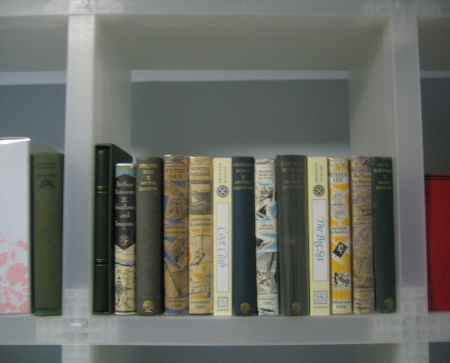
The Swallows & Amazons books by Arthur Ransome (and one other).
Finished my review of Portable Childhoods by Ellen Klages (Tachyon, 2007) for an upcoming issue of The New York Review of Science Fiction , and what a book ! “ In the House of the Seven Librarians ” is a playful, feminist mirror to Borges’ “ The Library of Babel ” : a tale of an almost wholly self-contained universe of books (in a small American town), but a library whose librarians have names, and who are competent to deal with eruptions of the unexpected into their routine, such as an infant girl returned in payment of overdue book fines. Tachyon continues their tradition of outstanding collections of short fiction. Well worth reading.
Bruce Sterling, in his Beyond the Beyond blog, has been finding some interesting signals about the impending death of print (including a good graphic image from the Jeff Gomez blog). The death of print discussion resembles the death of science fiction discussions that seem to recycle themselves in spontaneous fashion. In some areas — compilations of facts and information that become outdated before the ink is dry — this has been a trend for twenty years or more. I think the electronic book reading device has a few more iterations to cycle through before it really competes with the printed book. Anyway, I expect to make a few more books before the medium vanishes. Even the printed newspaper seems to have a few more miles to go ; or is the proliferation of free dailies evidence of such overcapacity at printing plants that one must view them as the last swirling leaves before the dead of winter ?
I am reminded of Jim Crace’s first novel, The Gift of Stones (1988) about a village of flint-chippers at the dawn of the age of bronze. Crace spent time in the Midlands rust belt ; when he read on the radio from The Gift of Stones he recalled a Birmingham factory worker saying, we’ll always have the steel works. His first book, Continent (1986), is a collection of linked short stories dealing with an entirely imaginary land. Crace seems fond of the hoax and I turned up his amusing account of a “ ghost book ”, Useless America , on the Crace website maintained by Andrew Hewitt.
Beyond the Beyond is also where I learned about the excellent Strange Maps blog.
This project, to gather impressions of books that people are reading on public transport : train, subway, ferryboat, bus, has not quite come together yet. I need to wear my spectacles (to see titles at a distance), as well as to design a way to engage readers instead of using the stealthy approach. So it is always Public Transport Reading Week.
I will continue to invite readers to send lists (or images) of books seen on public transport to me : wessells [at] aol [dot] com.
This creaking and constantly evolving blog of the endless bookshelf : I expect that some entries will be brief, others will take the form of more elaborate essays and eventually I will become adept at incorporating photos or comments and interactivity. Right now you’ll have to send links to me, dear readers. [HW]
electronym : wessells
at aol dot com
Copyright © 2007 Henry Wessells
Produced by Temporary
Culture, P.O.B. 43072, Upper Montclair, NJ 07043 USA.

